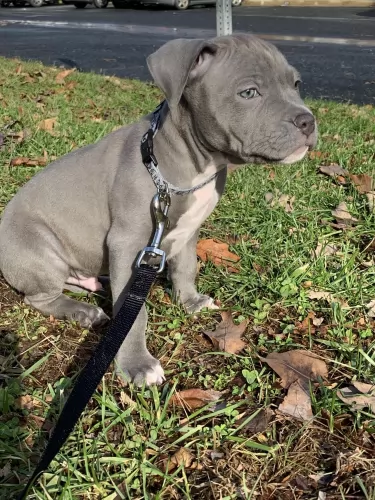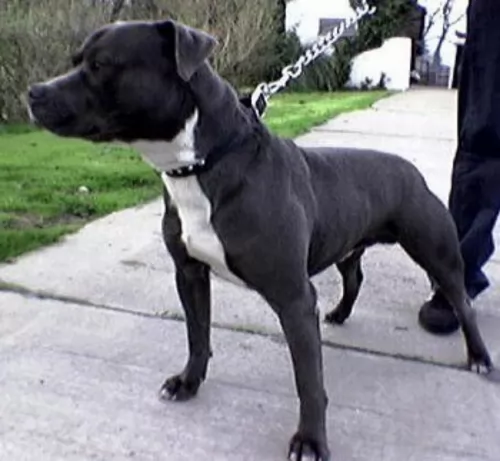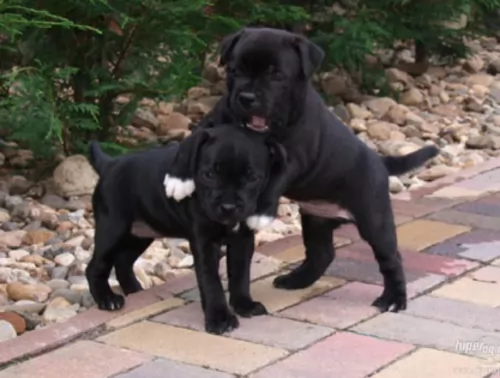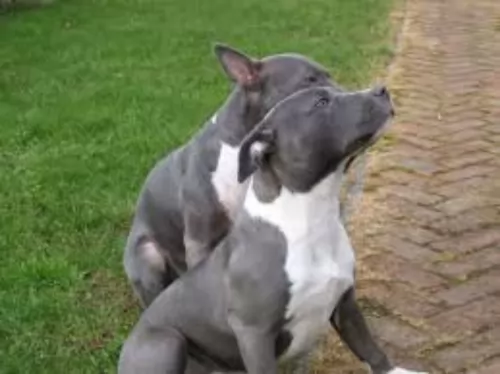 Petzlover
Petzlover Flat-Coated Retriever is originated from United Kingdom but Irish Staffordshire Bull Terrier is originated from Ireland. Flat-Coated Retriever may grow 13 cm / 6 inches higher than Irish Staffordshire Bull Terrier. Flat-Coated Retriever may weigh 18 kg / 40 pounds more than Irish Staffordshire Bull Terrier. Flat-Coated Retriever may live 4 years less than Irish Staffordshire Bull Terrier. Both Flat-Coated Retriever and Irish Staffordshire Bull Terrier has almost same litter size. Flat-Coated Retriever requires Moderate Maintenance. But Irish Staffordshire Bull Terrier requires Low Maintenance
Flat-Coated Retriever is originated from United Kingdom but Irish Staffordshire Bull Terrier is originated from Ireland. Flat-Coated Retriever may grow 13 cm / 6 inches higher than Irish Staffordshire Bull Terrier. Flat-Coated Retriever may weigh 18 kg / 40 pounds more than Irish Staffordshire Bull Terrier. Flat-Coated Retriever may live 4 years less than Irish Staffordshire Bull Terrier. Both Flat-Coated Retriever and Irish Staffordshire Bull Terrier has almost same litter size. Flat-Coated Retriever requires Moderate Maintenance. But Irish Staffordshire Bull Terrier requires Low Maintenance
 The Flat-Coated Retriever traces its heritage to 19th century England. A popular gamekeepers’ dog, the actual descendants of the breed are not entirely known. Like so many well-established breeds, there are many lines of thought about the breed line. There is an unverified line of ancestry that includes the St. Johns Water Dog – an extinct breed from North America. Another story has Canadian sailors bringing their Newfoundlands to England and mixing them with Colliers and Setters. This story has more truth to it and it took 20 years to establish the final breed type.
The Flat-Coated Retriever traces its heritage to 19th century England. A popular gamekeepers’ dog, the actual descendants of the breed are not entirely known. Like so many well-established breeds, there are many lines of thought about the breed line. There is an unverified line of ancestry that includes the St. Johns Water Dog – an extinct breed from North America. Another story has Canadian sailors bringing their Newfoundlands to England and mixing them with Colliers and Setters. This story has more truth to it and it took 20 years to establish the final breed type.
The breed was originally a retriever with two purposes – to retrieve the hunters’ bounty on land and on water.
The Flat-Coated Retriever was then introduced to the United States as a gun dog. By 1873 it was a “stable type” and in 1915 the AKC recognized the breed. After this, their popularity grew quickly until the American public fell in love with the Golden Retriever and the Labrador Retriever. Then the Flat-Coated Retriever’s numbers and popularity fell. The irony was that both the Golden and the Labrador credited the Flat-Coated Retriever as an ancestor. The survival of the breed was questionable following World War Two. They were brought back by a specific breeding program in the 1960’s.
Breeders in the ‘60s made sure they bred for both show dogs and companion animals. The Flat-Coated Retriever survived and is less popular than other retrievers, but he has his fans. The breed is more popular in the United Kingdom than it is in the United States in part because of Best in Show wins at Crufts
 The Staffordshire Bull Terrier comes from Staffordshire, England, but the Irish Staffie was later developed by Irish breeders so its origin is essentially Ireland. They were developed from bulldogs and different terrier breeds.
The Staffordshire Bull Terrier comes from Staffordshire, England, but the Irish Staffie was later developed by Irish breeders so its origin is essentially Ireland. They were developed from bulldogs and different terrier breeds.
The dog was always used for bull baiting, but when this sport died out, the Irish breeders wanted to create a taller, leaner dog suited for dog fighting. When dog fighting was banned the breed became rare again, but today it has been restored and is essentially a popular companion pet.
 The Flat-Coated Retriever has a straight and strong topline with unique head, strong jaws, a long muzzle and small ears. His eyes are dark brown almonds with a friendly and intelligent expression. He has an arched neck and a moderately long tail. The Flat-Coated Retriever is more of an athlete, lighter and certainly more elegant than any other type or breed of retriever.
The Flat-Coated Retriever has a straight and strong topline with unique head, strong jaws, a long muzzle and small ears. His eyes are dark brown almonds with a friendly and intelligent expression. He has an arched neck and a moderately long tail. The Flat-Coated Retriever is more of an athlete, lighter and certainly more elegant than any other type or breed of retriever.
 The Irish Staffordshire Bull Terrier is a medium sized pure-breed dog standing at roughly 43 to 48cm and weighing anything from 14 to 18kg.
The Irish Staffordshire Bull Terrier is a medium sized pure-breed dog standing at roughly 43 to 48cm and weighing anything from 14 to 18kg.
He has a short, smooth coat which can be a mix of colors such as fawn, tan, black or brindle. The coat can also be bi-colored such as in fawn and white or black and white. He is a powerfully built dog with short legs which are fairly wide apart.
He has a large head and short muzzle with powerful jaws.Sometimes when he pants after a hectic bout of exercise he gets a comical, grinning look on his face. The ears are semi-erect, semi-upright and he has a long tail.
Your Irish Staffy is a feisty, confident dog that has been known to have a temperament which leads towards aggression. It is why he should be trained and socialized to make him more amicable and obedient. He is an intelligent and alert dog, so won't have difficulty with training.
A well trained and socialized Irish Staffordshire Bull Terrier will get on well with children in the home as he is a playful, jovial dog, always ready for a game.
 The Flat-Coated Retriever is great with children. Just be careful they don’t knock over small children in their enthusiasm.
The Flat-Coated Retriever is great with children. Just be careful they don’t knock over small children in their enthusiasm.
They are confident great family dogs. They are “thinking dogs” and need something to work for or they will work for themselves. They can be clowns.
They are adaptable although their size might preclude small locations without yards.
Smart, thinking all the time, they are very trainable. However, they are considered the “Peter Pan” of dogs – they never grow up.
 The older Irish Staffie has always been an aggressive type dog used for fighting, but today the modern breed is capable of being a splendid, entertaining, amicable pet with an even temper. He is feisty for sure, being brave, fearless, loyal and loving with his human family members.
The older Irish Staffie has always been an aggressive type dog used for fighting, but today the modern breed is capable of being a splendid, entertaining, amicable pet with an even temper. He is feisty for sure, being brave, fearless, loyal and loving with his human family members.
All it requires with this dog is to have a firm, loving upbringing, some training and socialization as well as good food and plenty of love and attention. Many dogs get labelled wrongly because of the humans that rear them the wrong way. When done correctly, the Irish Staffordshire Bull Terrier promises to be a wonderful, loving, loyal pet.
 Flat-Coated Retrievers have their share of health concerns from dysplasia to cancer. The breeds problems include:
Flat-Coated Retrievers have their share of health concerns from dysplasia to cancer. The breeds problems include:
Hemangiosarcoma, Osteosarcoma, Malignant Histiocytosis, and Fibrosarcoma. Studies show that about half of all Flat-Coated Retrievers die of cancer.
 The Irish Staffordshire Bull Terrier, just like with any other dog, has a good chance of living a good number of years if he is fed properly. He can live to be anything up to between 10 and 16 years.
The Irish Staffordshire Bull Terrier, just like with any other dog, has a good chance of living a good number of years if he is fed properly. He can live to be anything up to between 10 and 16 years.
Say what you like, good nutrition and the lifestyle you provide for your Irish Staffie will determine how long he lives. An unhappy dog that has to beg for love and attention won't do well. Your Irish Staffie can live to a ripe age but he is still at risk for certain health problems.
These mast cell tumors are graded according to their location in the skin. Certain dogs like Boxers and bulldogs are more susceptible to mast cell tumors than other breeds, and the Irish Staffie isn't immune either. Most times the tumor develops in an older dog, though young dogs have also been known to develop the tumor. These tumors can be inactive for a while and then experience some rapid growth with some redness and fluid build up. Immediate veterinary intervention will be required.
 He will be a medium size dog. Feed puppies 3-4 times a day about a 1/8 cup of high-quality food. Feed a puppy food designed for medium size dogs or specifically for retrievers.
He will be a medium size dog. Feed puppies 3-4 times a day about a 1/8 cup of high-quality food. Feed a puppy food designed for medium size dogs or specifically for retrievers.
Feed 2 times a day about !/2 cups of dry food per meal. Do not overfeed. They have a tendency to be obese.
Maintain a healthy weight and avoid exercise before and after meals. The good news is dysplasia and epilepsy are rare in the breed.
They are very energetic and need good exercise. Long walks and a yard to run in. Remember they are hunting dogs and will chase to retrieve things so don’t let them off leash outside your yard. They will excel at agility, tracking. Rally, obedience, swimming, hunting, and jogging. They make great therapy dogs.
 The Irish Staffie is an active dog, who is always game for anything. He will certainly need active owners who include him in all their activities. He has a lot of stamina and endurance and will want to join you on your walks, hikes and swimming. Ignoring his exercise needs can turn him into a restless, unhappy, frustrated, destructive dog.
The Irish Staffie is an active dog, who is always game for anything. He will certainly need active owners who include him in all their activities. He has a lot of stamina and endurance and will want to join you on your walks, hikes and swimming. Ignoring his exercise needs can turn him into a restless, unhappy, frustrated, destructive dog.
Having a short, smooth coat means your Irish Staffie being a low maintenance dog. He does shed a bit so his coat will need to be brushed at least twice a week to get rid of all those loose hairs. Its always a good opportunity to check him for fleas and ticks too.
If the short coat gets too dirty, a wipe down with a damp cloth can keep the coat bright and shiny. Certainly avoid bathing him too often as this can aggravate the skin.
Check his nails and trim them if they get too long. Check his ears and teeth as these are all problem areas which can contribute to your dog becoming ill.
Your Irish Staffie is such an energetic dog that he will need excellent food that promotes this energy. Whether you buy him the best commercially manufactured kibble, you want to also add in some home-made food such as cooked chicken, rice and vegetables as well as including some raw meat occasionally. The food you provide your Staffie with needs to be full of vitamins and minerals to avoid illness. Always make sure he has access to fresh, cool water.